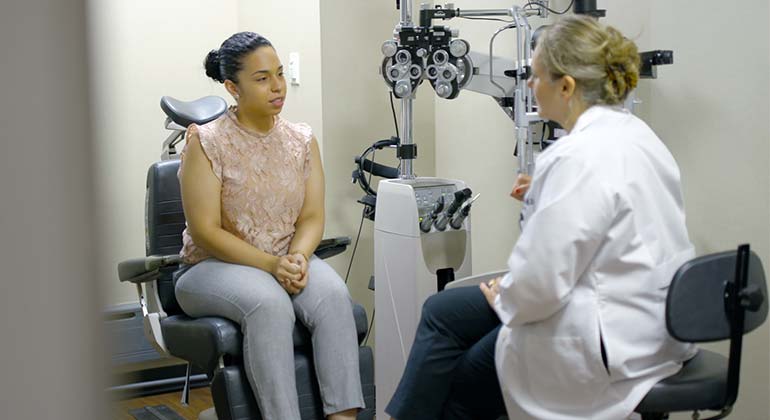The Advantages And Disadvantages of Various Refractive Surgeries for Boosted Eyecare

LASIK Surgical Treatment
LASIK surgery is a typically executed refractive treatment that aims to remedy vision concerns such as astigmatism, nearsightedness, and farsightedness. Throughout the procedure, a thin flap is developed on the cornea, and a laser is made use of to improve the underlying cells, correcting the refractive error.
One of the main benefits of LASIK surgical treatment is the quick improvement in vision experienced by many clients. Many people notice a considerable improvement in their vision soon after the treatment, with marginal downtime needed for healing. Furthermore, LASIK is known for its high success price and reduced incidence of complications when carried out by competent specialists. Nevertheless, like any type of operation, LASIK likewise carries some risks, consisting of completely dry eyes, glow, halos, and under or overcorrection of vision. It is essential for individuals thinking about LASIK surgical treatment to undergo a comprehensive evaluation by an eye care specialist to establish if they appropriate prospects for the treatment.
PRK Procedure
The PRK treatment, likewise understood as Photorefractive Keratectomy, is a type of refractive surgical treatment that intends to correct vision issues similar to LASIK surgical treatment. Unlike LASIK, which entails creating a flap in the cornea, PRK functions on the surface area layer of the cornea.
One of the benefits of PRK over LASIK is that it removes the danger of flap-related problems because no flap is developed during the surgical procedure. In spite of the longer recuperation period, PRK can be a suitable option for individuals seeking vision correction surgical treatment.
SMILE Surgery
A sophisticated refractive surgical treatment strategy acquiring appeal in the area of ophthalmology is SMILE Surgery. Little Laceration Lenticule Extraction (SMILE) is a minimally intrusive procedure that deals with vision by reshaping the cornea using a femtosecond laser. Unlike conventional LASIK surgical procedure, SMILE Surgical treatment entails producing a small cut in the cornea to extract a lenticule, which results in less disruption to the corneal structure and potentially much faster healing times.
Among the key benefits of SMILE Surgical treatment is its capacity to deal with myopia (nearsightedness) and astigmatism with high accuracy, resulting in excellent visual results for people. The minimally invasive nature of the treatment additionally minimizes the threat of problems such as dry eye disorder, making it a beneficial option for people looking for refractive surgery.

LASEK Technique
Having actually checked out the advantages and factors to consider of SMILE Surgical procedure, an additional notable refractive surgery strategy worth examining is the LASEK Technique. LASEK, which stands for Laser-Assisted Subepithelial Keratectomy, is a type of laser eye surgery that aims to deal with refractive errors such as myopia (nearsightedness), hyperopia (farsightedness), and astigmatism.
Unlike LASIK, LASEK does not include developing a corneal flap. Rather, throughout a LASEK procedure, the specialist makes use of a watered down alcohol remedy to loosen up the slim external layer of the cornea, referred to as the epithelium. This layer is then carefully moved aside to enable the laser to improve the underlying corneal cells. As soon as the cornea has been reshaped to the desired level, the epithelial layer is repositioned.
Among the key benefits of LASEK is that read the article it can be appropriate for individuals with thin corneas who may not be excellent prospects for LASIK. Furthermore, LASEK usually results in minimal post-operative discomfort and a quicker recuperation time contrasted to PRK. Nevertheless, the aesthetic healing procedure with LASEK may be slightly longer than with LASIK.
Implantable Call Lenses
Implantable Contact Lenses supply a long-term vision correction remedy for people seeking an alternative to standard contact lenses or glasses. These lenses, likewise referred to as phakic intraocular lenses, are surgically put right into the eye to correct refractive errors such as nearsightedness (nearsightedness), hyperopia (farsightedness), and astigmatism. eye doctors in andalusia. Unlike typical call my site lenses that remain on the surface of the eye, implantable call lenses work within the eye itself, giving clear vision without the requirement for day-to-day upkeep or removal
Among the vital advantages of implantable get in touch with lenses is their durability. Once placed, they can continue to be in the eye indefinitely, using constant and steady vision adjustment. Additionally, these lenses can be a superb choice for individuals who are not great candidates for laser eye surgical treatment or who prefer a reversible vision improvement procedure.
Nonetheless, implantable call lenses do bring some threats, including the possibility for these details cataracts or boosted eye pressure. It is crucial for people considering this choice to speak with an eye treatment professional to figure out if implantable call lenses are the right option for their particular requirements and eye health and wellness.
Conclusion
To conclude, each sort of refractive surgical treatment has its own advantages and drawbacks. LASIK surgical procedure is preferred for its quick recovery time, while PRK procedure might appropriate for people with thin corneas. SMILE surgery offers marginal pain during the procedure, but LASEK method may have a longer recovery process. Implantable contact lenses give an option for those that are not suitable prospects for traditional surgical treatments. Patients must consult with their eye care service provider to determine the ideal alternative for their individual demands.

Generally, SMILE Surgical procedure presents an appealing choice for individuals looking to improve their vision with refractive surgical procedure.